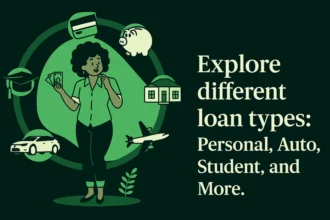In the United States, financial hardship is a pervasive issue, with Houston emerging as a hotspot, as indicated by a WalletHub report. This scenario underlines the critical need for a thorough comprehension of the loan process within the realm of personal finance.
For numerous individuals grappling with financial adversity, loans serve as a lifeline to alleviate their expenses. Acquiring knowledge on how loans work empowers individuals to make more informed choices regarding their financial standing.
We will dissect the loan process into its constituent parts, aiming to illuminate this complex financial domain. By mastering the basics of loans, individuals can more effectively tackle their financial predicaments.
Key Takeaways
- Understanding the loan process is imperative for managing personal finances.
- Loans can offer financial respite for individuals facing hardships.
- A clear comprehension of loan options can facilitate more astute financial decisions.
- The loan process encompasses several critical steps that borrowers must grasp.
- Informed financial choices can mitigate financial strain.
Understanding the Basics of Loans
The comprehension of loan fundamentals is imperative for the formulation of sound financial strategies. A loan represents a financial transaction where an individual borrows capital from a lending institution, obligating repayment with accrued interest. The significance of grasping financial product nuances is underscored by GOBankingRates, advocating for informed decision-making processes.
Diverse types of loans exist, each tailored for distinct financial needs. Personal loans facilitate debt consolidation, home renovation financing, or unforeseen expense coverage. In contrast, mortgages are exclusively for real estate acquisition. This exploration aims to elucidate these categories, facilitating a deeper understanding of the lending landscape.
Loans are differentiated into secured vs. unsecured categories based on collateral requirements. Secured loans necessitate collateral, which the lender can seize in the event of default. Unsecured loans, lacking collateral, often bear higher interest rates, reflecting the lender’s elevated risk exposure.
The repayment terms of loans are another critical dimension. These terms dictate the duration within which borrowers must settle their obligations. While extended repayment periods may lower monthly installments, they can escalate the total loan cost due to interest accrual. An article on CNET illustrates the dramatic increase in student loan payments for SAVE borrowers, underscoring the necessity of comprehending repayment terms.
In summary, the essence of loan understanding lies in recognizing the various categories and their inherent characteristics. Such knowledge empowers borrowers to make more astute financial choices, aligning with their individual circumstances.
The Loan Application Process
The loan application process encompasses a series of critical steps that borrowers must traverse to attain approval. Mastery of these steps enables borrowers to compile the requisite information, elevating their prospects for a successful application.
Lenders initially demand that borrowers furnish financial data, encompassing income verification, employment history, and credit reports. This data serves as the foundation for evaluating the borrower’s creditworthiness and their capacity to fulfill repayment obligations.
The loan approval criteria differ across lenders, yet a common thread is the consideration of credit score, debt-to-income ratio, and the loan amount’s proportionality to the collateral’s value (if applicable). A commendable credit history is indispensable, as it significantly influences the lender’s confidence in the borrower’s repayment capability.
The loan application process is comprised of several essential phases:
- Pre-qualification: An initial evaluation of the borrower’s creditworthiness.
- Application submission: Borrowers submit detailed financial information.
- Processing: The lender scrutinizes the application and may solicit additional information.
- Approval: The lender determines whether to approve the loan based on the loan approval criteria.
- Disbursement: The loan amount is disbursed to the borrower.
By comprehending the loan application process and preparing diligently, borrowers can enhance their likelihood of securing a loan that fulfills their requirements.
Interest Rates Explained
The comprehension of loan interest rates is imperative for the execution of informed borrowing decisions. These rates significantly influence the total financial burden of a loan, with financial experts affirming their critical importance for borrowers.
Interest rates delineate the cost of borrowing, quantified as a percentage of the principal loan amount. They can manifest as either fixed or variable, contingent upon the loan’s stipulations. Fixed interest rates persist unchanged throughout the loan’s duration, whereas variable interest rates fluctuate in response to market dynamics.
The genesis of interest rates is multifaceted, encompassing the borrower’s credit score, loan magnitude, and repayment duration. Lenders also scrutinize market conditions and the broader economic landscape. For example, in a scenario of low-interest rates, the affordability of borrowing is enhanced, as evidenced by recent trends where declining interest rates have prompted a reevaluation of home loan choices.
How Interest Rates Affect Loan Repayments
Interest rates have a direct bearing on loan repayment schedules. An elevated interest rate necessitates higher monthly installments, whereas a diminished rate results in reduced payments. To exemplify, consider a $10,000 loan with a 5-year repayment schedule. At an interest rate of 6%, the monthly payment would approximate $193. In contrast, an 8% interest rate escalates the monthly payment to about $203.
- A lower interest rate can lead to financial savings over the loan’s duration.
- A higher interest rate escalates the loan’s total cost.
- Fixed rates ensure consistent monthly payments.
- Variable rates may offer initial rate advantages but carry the risk of future rate hikes.
In the context of borrowing, it is fundamental to consider the interest rate and its implications on one’s financial standing. By grasping the mechanics of interest rates and their repercussions on loan repayments, borrowers can make more astute decisions, potentially leading to financial savings over the loan’s lifespan.
Loan Repayment Terms

Grasping the intricacies of loan repayment terms is imperative for adept debt management and the avoidance of fiscal calamities. The variability in loan repayment terms, contingent upon the loan’s nature and the lender’s stipulations, necessitates a thorough examination and comprehension prior to loan commitment.
Key Components of Loan Repayment Terms
- Loan Tenure: The duration over which you must repay the loan. Longer tenures may reduce monthly payments but increase the total interest paid.
- Repayment Schedule: The frequency and amount of payments. Understanding whether payments are monthly, bi-weekly, or another schedule is vital.
- Associated Fees: Late payment fees, prepayment penalties, and other charges can significantly impact the total cost of the loan.
Effective loan repayment management hinges on a profound comprehension of these elements. For example, the loan tenure’s knowledge facilitates long-term financial planning. A meticulously crafted repayment schedule is indispensable for budgeting, ensuring timely loan repayments.
- Set up automatic payments to ensure timely repayments.
- Consider consolidating debts if you have multiple loans with high interest rates.
- Review your budget regularly to accommodate any changes in loan repayment terms.
By mastering and adeptly managing loan repayment terms, borrowers can alleviate financial stress and enhance their credit score over time. It is advantageous to engage in dialogue with your lender in the event of repayment difficulties, as they may proffer alternatives or temporary relief measures.
Secured vs. Unsecured Loans
The distinction between secured and unsecured loans is fundamental for prudent financial planning. Borrowers are frequently confronted with the choice between these two loan types, a decision that profoundly influences both parties involved. This dichotomy is critical for understanding the dynamics of lending and borrowing.
A secured loan necessitates collateral, an asset that the lender can seize in the event of default. Typically, collateral encompasses homes, vehicles, and other substantial assets. This collateral provision mitigates the lender’s risk, as they possess a tangible asset to recover in the event of non-payment.
In contrast, an unsecured loan does not demand collateral. Instead, lenders base their approval on the borrower’s creditworthiness, income, and other relevant factors. Unsecured loans encompass personal loans, credit card debt, and student loans. Given the higher risk associated with unsecured loans, they frequently carry elevated interest rates compared to their secured counterparts.
The distinctions between secured and unsecured loans can be succinctly outlined:
- Collateral Requirement: Secured loans necessitate collateral, whereas unsecured loans do not.
- Risk Level: Secured loans are less risky for lenders due to the collateral, whereas unsecured loans are riskier and often have higher interest rates.
- Interest Rates: Secured loans typically have lower interest rates compared to unsecured loans.
- Examples: Secured loans include mortgages and auto loans, while unsecured loans include personal loans and credit card debt.
In deliberating between a secured and an unsecured loan, borrowers must assess their financial standing, the loan’s purpose, and their repayment capability. It is imperative to scrutinize the interest rates and terms proffered by lenders to ensure an informed decision.
The Role of Credit History
In the realm of loan applications, the significance of credit history cannot be overstated, as it is a critical component in the loan approval criteria assessment.
Adopting a strategy to maintain a commendable credit history is imperative for securing credit on advantageous terms. Financial experts concur that a superior credit score can substantially elevate your prospects for obtaining loans for borrowing money.
Credit scores serve as a metric for lenders to gauge an individual’s creditworthiness. A commendable credit score signifies a track record of prudent financial conduct, positioning you as a more desirable candidate for loan approval.
To uphold a robust credit history, consider the following recommendations:
- Ensure timely payments on your debts.
- Strive to maintain low credit utilization ratios.
- Regularly scrutinize your credit report for inaccuracies.
- Refrain from excessive credit applications within a brief timeframe.
Adherence to these principles will enhance your credit score, augmenting your likelihood of securing loans at competitive interest rates for borrowing money when required.
Understanding Loan Fees
The comprehension of loan fees is imperative for borrowers to adeptly manage their debt. Beyond the interest rate, various fees can profoundly influence the loan’s total cost.
Loans encompass several fee categories, including:
- Origination fees: These charges, levied by the lender for loan processing, typically span from 0.5% to 1% of the loan’s amount.
- Late payment fees: Non-payment can incur additional charges, with variability among lenders but often substantial.
- Prepayment fees: Some loans penalize early repayment, with fees being a percentage of the outstanding balance.
These fees can escalate rapidly, elevating the loan’s total cost. For example, an origination fee of 1% on a $10,000 loan increases the upfront cost by $100. Late payment fees can range from $25 to $50 or more per missed payment, contingent on the lender’s policies.
To mitigate the effects of these fees, borrowers must meticulously review the loan agreement prior to signing. Timely payments are also critical to avoid late fees. For those contemplating early loan repayment, it is essential to understand any prepayment fees.
For further insights into how loan fees impact specific loan types, such as student loans, refer to CNET’s article on student loan payments.
By acknowledging these fees and planning strategically, borrowers can more effectively manage their loan expenses and make more informed financial choices.
Alternatives to Traditional Loans

Traditional loans are not the sole option; numerous alternatives are worth considering. The evolving landscape of lending has introduced various alternatives to traditional loans, providing borrowers with more choices than ever before.
One such alternative is peer-to-peer lending, which connects borrowers directly with investors. This model can offer more competitive interest rates and flexible repayment terms. Financial experts emphasize the importance of understanding these alternatives for borrowers to make informed decisions.
- Lower operational costs due to the absence of traditional banking infrastructure
- Potential for lower interest rates for borrowers
- Varied loan terms and conditions
Another alternative is payday loans, which provide short-term financial relief. These loans, though, come with high interest rates and fees, making them a costly option. Borrowers should exercise caution and consider the risks involved.
“The rise of alternative lending platforms has democratized access to credit, but it’s essential for borrowers to understand the terms and conditions to avoid possible pitfalls.”
Other alternatives include:
- Credit union loans: Member-owned financial cooperatives that often offer more favorable terms
- Crowdfunding: Platforms that allow individuals to raise funds for specific needs or projects
- Invoice financing: Businesses can borrow against outstanding invoices to improve cash flow
When exploring these alternatives, it is imperative to weigh the benefits against the risks. We recommend a thorough review of the loan terms, interest rates, and repayment conditions before making a decision.
Tips for Responsible Borrowing
Engaging in responsible borrowing is imperative for preserving financial well-being. It necessitates a thorough comprehension of one’s financial boundaries and a prioritization of debt repayment. Financial experts underscore the significance of formulating a clear savings strategy for attaining financial equilibrium. For insights into managing emergency fund savings concurrently with debt repayment, refer to Finview News.
Adopting the following best practices is essential for responsible borrowing: conduct a thorough assessment of your financial standing, devise a budget, and allocate resources to vital expenses. It is critical to avoid debt pitfalls by comprehending the loan’s terms, including interest rates and repayment schedules. Upholding a commendable credit history is equally vital, as it influences your capacity to secure future loans.
By adhering to these guidelines for responsible borrowing, you can make well-informed decisions regarding borrowing and strive towards enduring financial stability.






